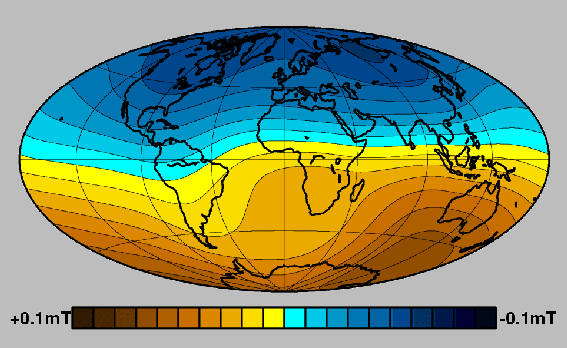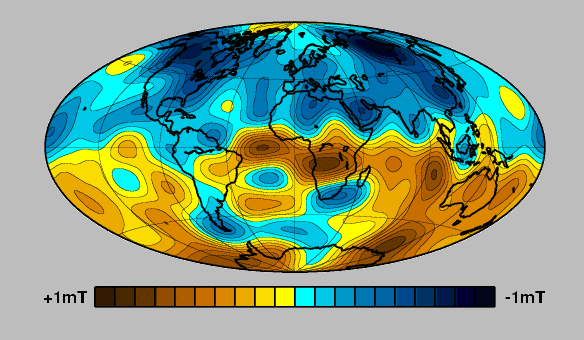
The Main Magnetic Field |
The majority of the magnetic field we measure at the Earth's surface comes
from sources internal to the Earth. By assuming that this field is a potential
field, we can use the measurements of the magnetic field (especially from
satellites) to construct a map of the large scale surface magnetic field
(wavelengths greater than order

|
| Radial magnetic field at Earth' surface |
Unfortunately, the same potential theory that allows us to generate this
map also tells us that formally we can say little more about the origin of the
field. All we can say for sure is that it originates within the Earth, but
where in the Earth cannot be distinguished. However, by looking at the
structure of the field - and making assumptions about its sources - we are able
to make further inferences.

|
| Spectrum of Field |
We have plotted the mean square field at the Earth's surface as a function
of the wavenumber of the field. It is clear that this spectrum has two parts,
first a rapidly declining part down to wavelengths of approximately
With these assumptions, we use the geomagnetic field to probe the structure
and dynamics of the Earth.

|
| Map of the long-wavelength radial field at the CMB |
The Earth's continents are superimposed to provide a geographical
reference. Compared with the map of the field at the Earth's surface
We can use the change of the field with time (the secular
variation) to elucidate the physics of the core. Imagine putting dye into
a river. The movement of the dye will tell us about the structure of water
flow in the river, until the dye eventually diffuses away. The magnetic field
provides a similar tracer for the flow at the top of the core. From estimates
of the electrical conductivity in the core, we believe that the effects of
diffusion are small on time scales of less than a century: thus, we may use the
secular variation to map the flow. While simple to state, this problem is not
straight-forward: additional assumptions about the nature of the flow are
required, in particular that it is large scale.

|
| Flow at the surface of the Core at epoch 2001.0 |
We see several clear features, in particular a large counter-clockwise gyre under the Indian ocean, another under the Northern Pacific ocean, and strong westward flow under the Atlantic, which is responsible for the westward drift. Note however, that the equatorial flow under the Indian and Pacific oceans is much weaker, and in some places even eastward. This demonstrates clearly that to understand processes in the core, we must consider models of the magnetic field at the CMB, and not at the Earth's surface. Flow models such as produced here provide information about the dynamics of the flow in the core, allowing modelling of decadal variations in the rate of Earth rotation, and constraint of the computer simulations of the geodynamo that are being produced by a number of different groups. More details can be found in my article on Large Scale Flow in the Core, in the recently published Treatise on Geophysics.
Richard Holme (holme@liv.ac.uk)